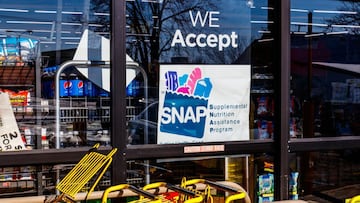Bad news for SNAP recipients: these are the dates Trump’s big, beautiful bill changes will take effect
Millions of SNAP recipients will have to deal with changes coming soon to the food assistance program under Trump’s signature budget legislation.

Republicans in Congress finally got President Donald Trump’s signature budget bill over the finish line and to his desk to be signed on the 4th of July. The sweeping legislation, whose details cover nearly 1,000 pages, includes new tax cuts, makes permanent some passed during Trump’s first term as well as billions in new spending for the military and his immigration policies.
In order to help offset the cost of the bill, which is still expected leave the US with a deficit that is $3.4 trillion larger, reductions were made to clean energy initiatives, and major reforms of Medicaid and the Supplemental Nutrition Assistance Program (SNAP). The latter two are predicted to leave millions without access to health insurance or food assistance.
What are the changes to SNAP?
One of the biggest changes to the SNAP program, that provides assistance for low-income families to put nutritious food on the table, is an expanded work requirement. Able-bodied adults between the ages of 19 and 64 must work, volunteer, be studying or training for at least 80 hours per month in order to qualify for benefits.
There will be exemptions to this eligibility requirement for parents of children 14 or younger.
Additionally, enrollees will have to deal with more paperwork and more frequent eligibility reviews.
There is no specific date set for these changes to be implemented but it could be as soon as this year.
Federal SNAP funding for states could drop
States could also see their federal funding for the program shrink. Currently, the federal government supplies 100% of the money for the program and states share in the administration costs.
However, those states that fail to get high error rates under control would have to bear a higher burden of the cost. Starting in 2028, states that have an error rate exceeding 6% of their SNAP funding will have to pay up to 15 percent of SNAP costs.
According to data from the Food and Nutrition Service at USDA, in 2024 only eight states had a combined over and under payment error rate under that threshold. Those states included Idaho, Nebraska, Nevada, South Dakota, Utah, Vermont, Wisconsin, and Wyoming.
Just looking at over payment error rates, sixteen states were below the 6% cap imposed by the legislation.
Get your game on! Whether you’re into NFL touchdowns, NBA buzzer-beaters, world-class soccer goals, or MLB home runs, our app has it all.
Dive into live coverage, expert insights, breaking news, exclusive videos, and more – plus, stay updated on the latest in current affairs and entertainment. Download now for all-access coverage, right at your fingertips – anytime, anywhere.

Complete your personal details to comment